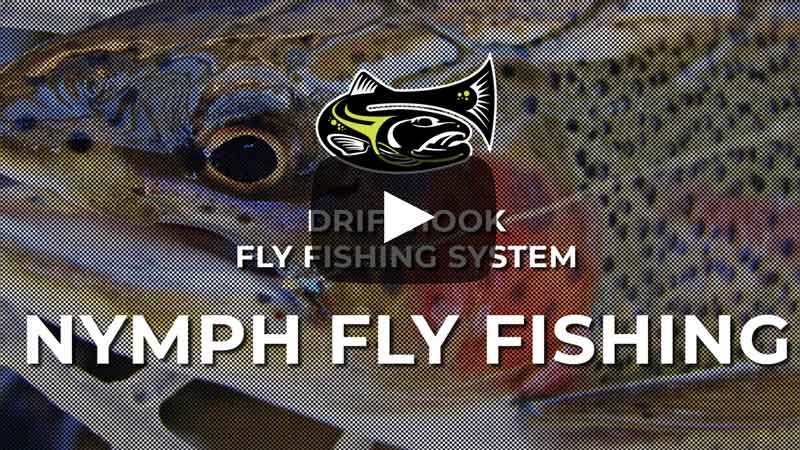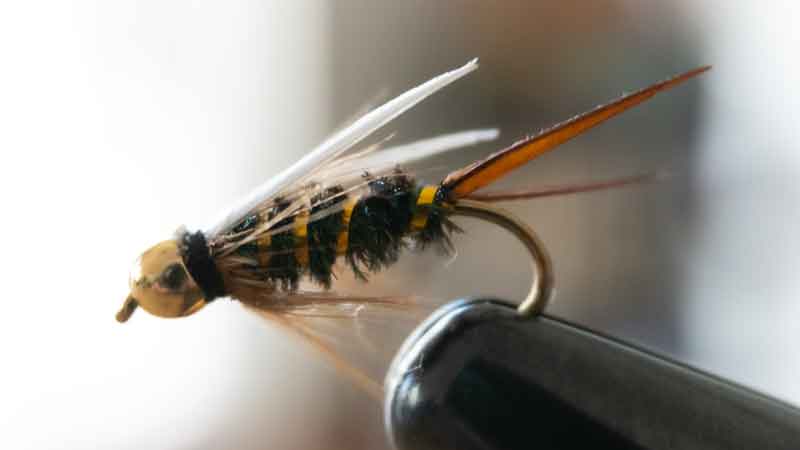Among the many fly patterns available to anglers, the bead head hare's ear nymph stands out as a timeless and versatile choice. This nymph pattern has earned its place in the fly boxes of anglers around the world due to its remarkable ability to imitate a wide range of aquatic insects, particularly mayfly nymphs, which are a crucial food source for trout and other fish species.
The bead head hare's ear nymph is celebrated for its simplicity and effectiveness. Its design incorporates natural materials like hare’s mask fur, which provides a lifelike texture and appearance, and a bead head that adds weight, helping the fly to sink quickly to the desired depth. The bead also introduces a subtle flash that can attract fish from a distance, making it a highly effective pattern in various water conditions.

Understanding the history and evolution of the bead head hare's ear nymph can provide valuable insights into why it remains a staple in fly fishing. Additionally, knowing how to tie this fly yourself enhances your angling skills and allows you to customize the pattern to match specific fishing conditions and personal preferences. In this article, we will delve into the origins of the bead head hare's ear nymph, the materials required, step-by-step instructions for tying it, variations of the pattern, and effective techniques for fishing it. Whether you are a seasoned fly angler or a beginner, mastering this pattern can significantly enhance your fly fishing experience.
What is the bead head hare's ear nymph?
The bead head hare's ear nymph is a staple in the fly fishing community, revered for its versatility and effectiveness in imitating various aquatic insects. This pattern is particularly popular for targeting trout, as it mimics nymphs' natural appearance and movement. The hare's ear nymph is crafted to resemble the natural nymphal stages of mayflies, caddisflies, and stoneflies, making it a highly effective imitation for a wide range of aquatic insects.

The addition of a bead head to the traditional hare's ear nymph was a game-changer in fly design. The bead, typically made of brass, tungsten, or copper, serves several crucial functions. First, it adds weight to the fly, allowing it to sink quickly and reach the feeding zone of fish. This is particularly useful in faster currents or deeper waters where a weighted fly is necessary to get down to where the fish are feeding. Second, the bead head introduces a subtle flash and sparkle, which can attract the attention of fish from a distance. This flash can be particularly effective in murky water or low-light conditions, increasing the fly's visibility and appeal.

The body of the hare's ear nymph is crafted using hare's mask fur, which has a natural, spiky texture that mimics the legs and gills of real nymphs. This natural appearance, combined with the movement created by the materials in the water, makes the bead head hare's ear nymph an irresistible target for trout and other fish species. Its ability to imitate a broad spectrum of aquatic insects makes it a versatile and essential fly in any angler's collection.
History of the bead head hare's ear nymph
The hare's ear nymph has a long and storied history in the world of fly fishing, with roots tracing back to the early 1900s in England. This classic pattern was developed to mimic the nymphal stage of various aquatic insects, which are a crucial part of the diet for many fish species, especially trout. The simplicity and effectiveness of the hare's ear nymph quickly made it a favorite among anglers, and it spread rapidly across Europe and eventually to North America and beyond.
The original hare's ear nymph was tied using natural materials, primarily hare's mask fur, which provided a lifelike texture and appearance. The use of natural materials was a common practice in traditional fly tying, as these materials often had the right combination of color, texture, and movement to effectively imitate natural prey. The hare's ear nymph proved highly effective in various fishing conditions, and its popularity soared.

The bead head version of the hare's ear nymph emerged later, adding a new dimension to this classic pattern. The innovation of adding a small metal bead at the head of the fly was a significant advancement in fly tying. This addition increased the fly's weight, allowing it to sink more quickly and reach the strike zone more efficiently and added a visual attractor. The bead head reflects light and adds a subtle flash, which can effectively attract fish.
Introducing the bead head hare's ear nymph revolutionized nymph fishing and quickly became a mainstay in fly boxes worldwide. This version of the hare's ear nymph retains the original's effectiveness while enhancing its ability to attract and catch fish. Today, the bead head hare's ear nymph is a go-to pattern for anglers targeting a wide range of fish species, and its enduring popularity is a testament to its effectiveness and versatility.
Materials needed for bead head hare's ear nymph

To tie a bead head hare's ear nymph, you will need the following materials:
- Hook: Nymph hook, sizes 12-18
- Bead: Gold or copper bead to fit the hook size
- Thread: Brown or black, 6/0 or 8/0
- Tail: Fibers from a hare's mask or similar material
- Ribbing: Gold or copper wire
- Abdomen: Hare's ear dubbing
- Wing case: Turkey tail or similar material
- Thorax: Darker hare's ear dubbing or peacock herl
How to tie bead head hare's ear nymph
To tie the bead head hare's ear nymph, we will summarize the steps from the video provided:
- Thread the Bead: Place the bead on the hook and secure the hook in the vise.
- Start the Thread: Begin wrapping the thread behind the bead to lock it in place.
- Create the Tail: Tie in a small bunch of hare's mask fibers at the hook bend to form the tail.
- Add the Ribbing: Tie in a piece of gold or copper wire for ribbing, extending it back to the tail.
- Dub the Abdomen: Apply hare's ear dubbing to the thread and wrap it forward to form the abdomen, stopping about two-thirds up the hook shank.
- Rib the Abdomen: Wrap the ribbing wire forward over the dubbed abdomen in evenly spaced turns, securing it near the thorax area.
- Form the Wing Case: Tie in a strip of turkey tail or similar material over the top of the abdomen.
- Dub the Thorax: Apply a darker dubbing or peacock herl to the thread and create a thorax just behind the bead.
- Finish the Wing Case: Pull the wing case material over the thorax and secure it just behind the bead, trimming any excess.
- Whip Finish: Perform a whip finish and add a drop of head cement to secure the thread wraps.
Bead Head Hare’s Nymph Variations
The bead head hare's ear nymph is a versatile and effective fly pattern that mimics a variety of aquatic insects. Over the years, fly tiers have created numerous variations to adapt this fly to different fishing conditions and target species. Here are some notable variations of the bead head hare's ear nymph from my assortment of flies:
Olive Hare's Ear Nymph

The olive hare's ear nymph uses olive dubbing instead of the traditional tan or brown. This variation is particularly effective in waters with greenish hues, which are common in many lakes and streams. The olive color can better match the natural coloration of the insects in these environments, making it a go-to pattern for many anglers.
- Materials: Olive dubbing, gold bead, olive ribbing, partridge tail.
- Advantages: Blends well in green-tinted waters, effective for imitating olive-colored nymphs like baetis.
Flashback Hare's Ear Nymph

The flashback hare's ear nymph incorporates a strip of flash material for the wing case, adding extra attraction in low-light conditions. The added flash can help catch the eye of fish, especially in deeper or murky waters where visibility is reduced.
- Materials: Traditional hare’s ear dubbing, gold bead, flashback strip (pearl or mylar), gold ribbing.
- Advantages: Increased visibility in low-light or murky conditions, adds an element of attraction.
Hare's Ear Black

The hare's ear black variation uses black dubbing to create a darker profile, making it effective in waters where darker nymphs are present. This pattern can be particularly useful in clear waters or during overcast days when a more subtle presentation is required.
- Materials: Black dubbing, gold or black bead, black ribbing, black tail.
- Advantages: Effective in clear water and during overcast conditions, matches darker nymph species.
Natural Hare's Ear Nymph

The natural hare's ear nymph stays true to the traditional pattern using natural hare's mask dubbing. This classic variation is versatile and effective in a wide range of fishing environments, closely resembling many natural aquatic insects.
- Materials: Natural hare’s mask dubbing, gold bead, gold ribbing, partridge tail.
- Advantages: Versatile and effective, closely mimics natural insects, reliable in various conditions.
Soft Hackle Hare's Ear Nymph

The soft hackle barbless hare's ear nymph variation uses a barbless hook, which is beneficial for catch-and-release fishing. Barbless hooks reduce harm to the fish and are often required in many fly fishing catch-and-release waters.
- Materials: Traditional hare’s ear dubbing, gold bead, gold ribbing, partridge tail, barbless hook.
- Advantages: Ideal for catch-and-release fishing, minimizes injury to fish, often required by regulations.
How to fish a bead head hare's ear nymph
Fishing a bead head hare's ear nymph can be highly effective using various techniques. Here are some tips from the Basic Guide to Nymphing When Fly Fishing:
- Dead Drift: Cast upstream and allow the nymph to drift naturally with the current, keeping slack out of the line for better strike detection.
- Indicator Nymphing: Use a strike indicator to help detect subtle takes. Adjust the indicator depth based on the water depth and fish activity.
- Euro Nymphing: Employ tight-line techniques to maintain direct contact with the fly, enhancing sensitivity to strikes.
- Swinging the Fly: Let the nymph swing across the current at the end of the drift, imitating an emerging insect.
- Dropper Rig: Use the bead head hare's ear nymph as the point fly in a dropper rig, with another nymph or dry fly above it.
Mastering the bead head hare's ear nymph and understanding how to fish it effectively can significantly improve your success on the water. This versatile and time-tested pattern remains a favorite among fly fishers for good reason—its ability to imitate various aquatic insects and attract fish consistently makes it an essential fly in any angler's box.

The bead head hare's ear nymph is a quintessential pattern that should be part of every fly fisher’s arsenal. Its long-standing history and proven effectiveness make it a timeless choice for anglers targeting trout and other fish species. The versatility of the hare's ear nymph, coupled with the added benefits of a bead head, ensures that it can imitate a wide variety of aquatic insects, making it suitable for numerous fishing conditions and environments.

![Bead Head Hare's Ear Nymph [Tie, Fish, Catch]](http://drifthook.com/cdn/shop/articles/Bead-Head-Hare_s-Ear-Nymph-Drifthook.jpg?v=1718051684&width=1500)



![Ultimate Pheasant Tail Nymph Guide [Tie, Fish, Catch]](http://drifthook.com/cdn/shop/articles/Ultimate-Pheasant-Tail-Nymph-Guide.jpg?v=1717080188&width=800)